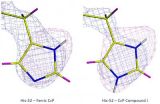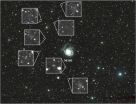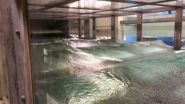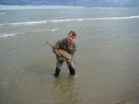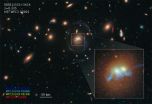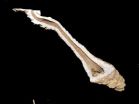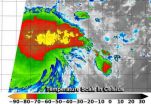(Press-News.org) The controversy centres around a family of enzymes known as heme enzymes, due to the presence of a heme group in their active site. At the centre of the heme cofactor is an iron (Fe) atom, which becomes oxidised (ferryl) when a reacting heme is in an intermediate state called Compound I. The question that has remained unanswered for decades is whether this oxidation involves just an oxygen atom (O), or a hydroxyl group (OH). Resolving this fundamental question has implications for understanding oxidative processes within living cells, which is critically important for drug development.
Professors Peter Moody and Emma Raven from the University of Leicester, worked with Dr Matthew Blakeley, Dr Susana Teixeira and Cecilia Casadei from the Institut Laue-Langevin, along with scientists from the Maier-Leibnitz Zentrum (MLZ) and the University of Manchester to solve the mystery of the ferryl heme Compound I structure using a method that has not previously been applied to this problem: neutron crystallography.
Structures of proteins are commonly determined using X-ray crystallography, however hydrogen atoms are not generally located due to their weak scattering with X-rays. Neutron protein crystallography, on the other hand, allows the positions of the hydrogen atoms to be located, while also avoiding radiation damage of the sample that can occur with X-rays.
The enzyme used in the study was cytochrome c peroxidase (CcP), which was isolated, purified and then crystallised in preparation for the neutron studies. First the neutron structure of CcP in its resting state at room temperature was determined using data collected on the LADI-III instrument at the ILL. Next, a CcP crystal was reacted with hydrogen peroxide to form its Compound I intermediate and immediately cooled to -173° to cryo-trap the intermediate state. Then neutron data were collected on the Compound I crystal at cryogenic temperatures using the BioDiff instrument at FRM-II, allowing the neutron structure of Compound I to be determined.
And the answer turns out to be… the ferryl heme in Compound I is not protonated. But, unexpectedly, the results showed that one of the amino acid side chains (a histidine) on the molecule is doubly protonated, which raises questions of its own in terms of mechanisms for oxygen activation in heme enzymes.
"Cryo-cooling of the large protein crystals that are required in neutron crystallography was traditionally considered a challenge", said ILL PhD student Cecilia Casadei. "Our work shows the feasibility of this, enabling the low temperature capture of intermediate species in enzyme reaction pathways by neutron crystallography. The LADI-III instrument at the ILL and the BioDiff instrument at FRM-II exploit the unique capabilities of neutron diffraction for the localization of hydrogen atoms in protein structures, which is so often essential for a full understanding of reaction mechanism and catalytic activity."
"This research marks the first time a trapped enzyme intermediate structure has been determined using neutron cryo-crystallography, shedding light on a well-known but unclear catalytic mechanism." said Matthew Blakeley, LADI-III scientist at Institut Laue-Langevin. " Now we have the ability to collect data at various temperatures, this opens the way to address many more complex biological problems using neutron crystallography."
"Finding out where all the hydrogens are is key to understanding the way enzymes work," said Professor Moody. "The ability to capture intermediates at cryogenic temperatures combined with the information available from neutron crystallography, means that we can finally see them."
"The exact structure of ferryl heme has been a long and difficult problem for the heme community to resolve," said Professor Raven. "Through our collaborators in Grenoble and Munich, we have been lucky to have had access to excellent neutron beamlines in Europe, which has meant that we were in an excellent position to try new and different approaches that worked very nicely."
The associated paper in Science cane be found here: http://www.sciencemag.org/content/345/6193/193.abstract
INFORMATION: END
Neutron crystallography solves long-standing biological mystery
2014-07-10
ELSE PRESS RELEASES FROM THIS DATE:
Astronomers find 7 dwarf galaxies with new telescope
2014-07-10
Meet the seven new dwarf galaxies.
Yale University astronomers, using a new type of telescope made by stitching together telephoto lenses, recently discovered seven celestial surprises while probing a nearby spiral galaxy. The previously unseen galaxies may yield important insights into dark matter and galaxy evolution, while possibly signaling the discovery of a new class of objects in space.
For now, scientists know they have found a septuplet of new galaxies that were previously overlooked because of their diffuse nature: The ghostly galaxies emerged from the night ...
Study provides new approach to forecast hurricane intensity
2014-07-10
VIDEO:
This is the one-of-a-kind, Alfred C. Glassell, Jr., SUSTAIN research facility at the UM Rosenstiel School of Marine and Atmospheric Science, where Haus and colleagues will conduct further studies on...
Click here for more information.
MIAMI – New research from University of Miami (UM) Rosenstiel School of Marine and Atmospheric Science suggests that physical conditions at the air-sea interface, where the ocean and atmosphere meet, is a key component to improve forecast ...
Extinct sea scorpion gets a Yale eye exam, with surprising results
2014-07-10
Poor peepers are a problem, even if you are a big, bad sea scorpion.
One minute, you're an imperious predator, scouring the shallow waters for any prey in sight. The next, thanks to a post-extinction eye exam by Yale University scientists, you're reduced to trolling for weaker, soft-bodied animals you stumble upon at night.
Such is the lot of the giant pterygotid eurypterid, the largest arthropod that ever lived. A new paper by Yale paleontologists, published in the journal Biology Letters, dramatically re-interprets the creature's habits, capabilities, and ecological ...
Despite setback, 'Mississippi Baby' represents significant breakthrough in effort to end AIDS
2014-07-10
Washington, D.C.—July 10, 2014—In response to today's announcement that the "Mississippi Baby," believed to have been functionally cured of HIV, has now been found to have detectable levels of the virus, the Elizabeth Glaser Pediatric AIDS Foundation (EGPAF) expresses disappointment in this setback but remains hopeful that the scientific breakthrough that allowed the child's HIV levels to remain undetectable for more than two years will continue to help researchers understand how to control HIV and ultimately develop a cure.
"Although we had high hopes that the child ...
Hubble spots spiral bridge of young stars linking two ancient galaxies
2014-07-10
NASA's Hubble Space Telescope has photographed an unusual structure 100,000 light years long, which resembles a corkscrew-shaped string of pearls and winds around the cores of two colliding galaxies.
The unique structure of the star spiral may yield new insights into the formation of stellar superclusters that result from merging galaxies and gas dynamics in this rarely seen process.
"We were surprised to find this stunning morphology. We've long known that the 'beads on a string' phenomenon is seen in the arms of spiral galaxies and in tidal bridges between interacting ...
Active shooter training increases comfort level of emergency responders
2014-07-10
(Boston) – Emergency Medical Service (EMS) responders felt better prepared to respond to an active shooter incident after receiving focused tactical training according to a new study in the journal Prehospital and Disaster Medicine. This is the first study to specifically examine the EMS provider comfort level with respect to entering a scene where a shooter has not yet been neutralized or working with law enforcement personnel during that response.
Incidents such as the Columbine High School shooting, the Virginia Tech campus shooting, the 2009 Fort Hood shooting, the ...
Scorpions are master architects, according to new research from Ben-Gurion University
2014-07-10
BEER-SHEVA, Israel – Ben-Gurion University of the Negev scientists have discovered that scorpions create a platform in their burrows where they warm up before the evening hunt.
As ectothermic animals, scorpions rely on energy from the environment to regulate
their internal temperature. The researchers believe that this platform provides a safe, warm spot for the scorpions to increase their body temperature before they leave their hiding places to forage at night.
After trapping the wild large-clawed scorpions (Scorpio maurus palmatus) in Israel's Negev desert the ...
NASA-NOAA Suomi NPP satellite sees power within newborn Tropical Depression 09W
2014-07-10
As the Northwestern Pacific is bidding goodbye to Tropical Cyclone Neoguri, another tropical depression has formed. NASA-NOAA's Suomi NPP satellite passed over Tropical Depression 09W (TD09W) and captured infrared data on the storm indicating some powerful thunderstorms within.
Because TD09W is close to land areas, watches are already in effect. On July 10, a tropical storm watch is in force for Guam, Rota, Tinian and Saipan.
Tropical depression 09W was formerly known as low pressure System 92W. VIIRS instrument aboard NASA-NOAA's Suomi NPP satellite taken July 10 at ...
Scripps Florida scientists shed new light on nerve cell growth
2014-07-10
JUPITER, FL, July 10, 2014 – Amidst the astounding complexity of the billions of nerve cells and trillions of synaptic connections in the brain, how do nerve cells decide how far to grow or how many connections to build? How do they coordinate these events within the developing brain?
In a new study, scientists from the Florida campus of The Scripps Research Institute (TSRI) have shed new light on these complex processes, showing that a particular protein plays a far more sophisticated role in neuron development than previously thought.
The study, published in the journal ...
On the link between periodontitis and atherosclerosis
2014-07-10
Chronic oral infection with the periodontal disease pathogen, Porphyromonas gingivalis, not only causes local inflammation of the gums leading to tooth loss but also is associated with an increased risk of atherosclerosis. A study published on July 10th in PLOS Pathogens now reveals how the pathogen evades the immune system to induce inflammation beyond the oral cavity.
Like other gram-negative bacteria, P. gingivalis has an outer layer that consists of sugars and lipids. The mammalian immune system has evolved to recognize parts of this bacterial coating, which then ...
